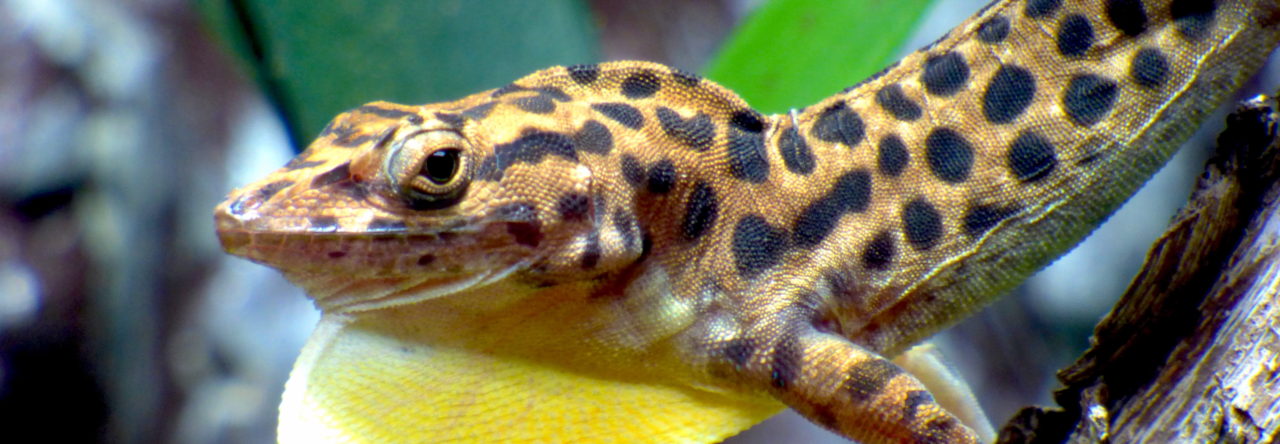If you are lucky enough to live in the tropics then you can do away with incubators, endless tinkering with temperature, humidity and light regimes and let nature do it for you. I have been breeding A. apletophallus in Panama for almost two years and thought I should share with you my take on breeding anoles “in situ.”
I use a very basic shade house that is situated on the edge of the forest. The temperature and humidity are similar to the forest where the lizards live. In the shade house, the lizards are housed individually in mesh cages that I constructed from pop-up laundry hampers and mesh bags. Each cage is outfitted with three branches and a plastic leaf. Females have a shallow soil plate to lay eggs in, which they happily do. I feed adult lizards every three days and at the same time check for eggs. All eggs are removed and placed in a plastic cup with water and cotton wool, which is then placed inside a ziplock bag. Eggs are “incubated” at ambient temperature (~45 days). When the eggs hatch the hatchlings are transferred to plastic boxes with a mesh lid. These “baby boxes” also contain three small branches and a plastic leaf. Hatchlings and subadults are feed every other day. All lizards are sprayed daily with water. Although there is probably room for improvement, this has been a successful and economical strategy to breeding anoles in the tropics. For anyone who wants more details I have posted this on my webpage under “animal husbandry.”
- From Across the Pond: Anole Presentations at ESEB 2015 - August 19, 2015
- Panamanian Anole Population in Decline - February 15, 2015
- Twin embryos - April 13, 2013



Pat Shipman
My question is: how do you know when the females are pregnant?
Jessica Stapley
Good point. The females mature at about 40mm SVL. Females caught in the wild that are larger than 40mm SVL have already mated and start laying fertile eggs immediately and continuously until them become sperm depleted (up to 4 months). They are able to breed/lay eggs all year round, although in the field the egg production slows in the dry season. I know when young females (<40mm SVL) or females born in the lab mature because they start producing infertile eggs. Infertile eggs are yellow and soft and are not usually buried in the soil – unlike fertile eggs that are white, harder and normally buried. In order to mate a virgin female in the lab, I place a male in the female's cage for ~1-2 days.
Yoel Stuart
Jessica, thanks for sharing. How great to have natural heat and humidity! Seems much better than having to harness heaters and humidifiers to battle the frequent air exchanges typical of modified mouse rooms.
Thomas Sanger
What a cool breeding system! Nice work.
Anthony Geneva
Jessica, nice post. The advantages of working in natural environment are clearly great. As Yoel mentioned, managing temperature, humidity and light in a lab can be challenging. Have you had any problems associated with working in situ such as disease, parasites, extreme weather?
Jessica Stapley
I have had my fair share of problems. Putting your lizard house in almost complete shade means you are under the trees and tropical trees are fairly prone to loosing limbs. I had to replace the canopy of my shade house after a large branch fell on it. The other thing to consider is predators. The main reason I have the cages hanging on wires off the ground is because of ants. These would devour my lizards if they had the chance. I also had a mouse opossum eat a few of my lizards. As for disease and parasites I don’t think these pose a big threat, because the animals live locally they are not exposed to anything new. I don’t treat my lizards for parasites when I bring them into the lab. Weather is pretty stable in Panama. My biggest worry is high temperatures in the dry season, but by using a spray system you can bring the temperature down a degree or two. The lizard house is also in an area a little prone to flash flooding another good reason to have the cages off the ground.
Maggie Lee
Hi how much are the mesh hangers please?
Jessica Stapley
Hi Maggie
I bought the laundry hampers at a Panamanian store, they were less than $1 each. I have seen them on the internet for about the same price – if you buy in bulk. I put mesh bags over the hampers, these were made from netting that I bought from a local material shop and sewn by hand.
Hope this helps
Jessica